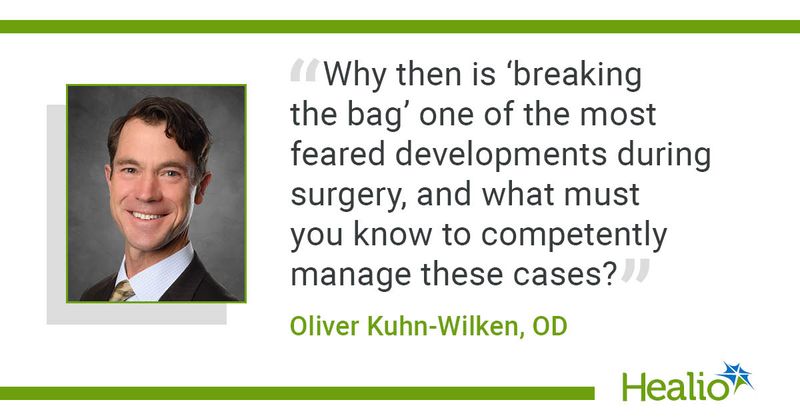BLOG: What’s so bad about breaking the bag?
A tear of the posterior capsule is a common intraoperative complication and will occur occasionally even with the most experienced surgeons. If you comanage cataract patients, you have seen a broken capsule.
Very often, these patients appear normal after surgery, with an eye that is indistinguishable from any other postop eye, excellent acuity and a normal recovery. Why then is “breaking the bag” one of the most feared developments during surgery, and what must you know to competently manage these cases?

The complication goes by many names, including posterior capsular tear (PCT), posterior capsular break, capsular rupture and capsular rent. This article will refer to it as PCT. PCTs occur in less than 1% of all cataract surgeries (Artzén et al; Segers et al).
With a thickness of just 4 µm to 9 µm, the posterior capsule is delicate — and, unfortunately, serves as the backstop for all the heavy demolition work being done on the cataract. The capsule can break at any time during surgery, but the most common time for rupture is toward the end of the phacoemulsification stage. When the capsule breaks, the surgery instantly turns from a fairly simple procedure into a much more complicated one.
Intraoperative challenges
There are three challenges a surgeon may face when a PCT occurs, the first of which is prolapse of the vitreous. The capsule is a barrier to the vitreous, so when PCT occurs, vitreous pushes forward into the anterior chamber. Therefore, a PCT will almost always force the surgeon to perform an anterior vitrectomy.
Secondly, fragments of the cataract can slip back through the rent into the posterior segment, often necessitating a second surgery with a retina specialist to extract them.
Finally, the capsule can be compromised enough that it can no longer serve as a support for the incoming IOL, and the surgeon must resort to other, more difficult maneuvers to position and stabilize the IOL.
The chief risk factors for a PCT are a weakened capsule or zonules due to prior trauma, pseudoexfoliation, previous vitrectomy or even intraocular injections; true posterior polar cataracts, in which the capsule can have a tear even before the surgery; and situations in which the surgeon’s view of the capsule is difficult, including very dense cataracts, small pupils and intraoperative floppy iris syndrome. For more on IFIS, see my previous blog post on the topic.
Since the capsule is transparent, you may or may not be able to visualize the tear; often you will only know because of the surgeon’s note.
Postoperative complications
Any PCT greatly increases the risk of postoperative complications. There are three primary risks to which you should be alert.
First, if the surgeon was unable to get out of all the vitreous, you may notice some in the anterior chamber. As vitreous is quite clear, you are more likely to see a line of immobile pigment, signifying a strand of vitreous, rather than the vitreous itself. If the vitreous became trapped in one of the incisions, you’ll see a peaked pupil that points to the entrapping incision. This is referred to as vitreous wick syndrome and is a high-risk situation for endophthalmitis; it should be returned to the surgery center immediately.
Second, the higher level of inflammation secondary to the more traumatic surgery means that the risk of cystoid macular edema (CME) rises from 1.4% for uncomplicated cataract surgeries to 7.3% in a case of PCT, a fivefold increase (Healy et al). CME typically manifests weeks after surgery and should be quickly managed, so patients should be warned to call you if they notice slowly progressive blur.
Third, PCT greatly increases the risk for eventual retinal detachment (RD), likely due to the anterior movement of the vitreous during prolapse and during vitrectomy. In fact, there is a higher rate of retinal tears opposite the primary incision, suggesting that the surgeon’s vitrector is inducing vitreous traction and pulling on the retina (Moore et al).
The 5-year cumulative incidence of RD after uncomplicated cataract surgery is less than 0.4%, but with PCT this explodes to 8.3% (Clark et al). The risk can be imminent: Around a third of all RDs after PCT occur within 3 weeks (Jakobsson et al). The risk for RD is increased even more if nuclear lens fragments drop into the vitreous — to more than 12%. Any patient who has experienced a PCT should be warned of this risk and of the symptoms of RD.
A PCT is the most common complication during cataract surgery that can affect the patient’s final visual outcome. If you are managing a case of PCT, watch carefully for vitreous in the anterior chamber and discuss with your patient the symptoms of CME and RD.
References:
- Artzén D, et al. J Cataract Refract Surg. 2009;doi:10.1016/j.jcrs.2009.05.026.
- Clark A, et al. Arch Ophthalmol. 2012;doi:10.1001/archophthalmol.2012.164.
- Healy R, et al. Invest Ophthalmol Vis Sci. 2015:56(7).
- Jakobsson G, et al. J Cataract Refract Surg. 2009;doi:10.1016/j.jcrs.2009.05.028.
- Moore JK, et al. Ophthalmology. 2003;doi:10.1016/S0161-6420(03)00020-4.
- Segers MHM, et al. J Cataract Refract Surg. 2022;doi:10.1097/j.jcrs.0000000000000708.
For more information:
Oliver Kuhn-Wilken, OD, practices at Pacific Cataract and Laser Institute’s Tualatin Clinic in Oregon. He can be reached at Oliver.Wilken@pcli.com.
Collapse
